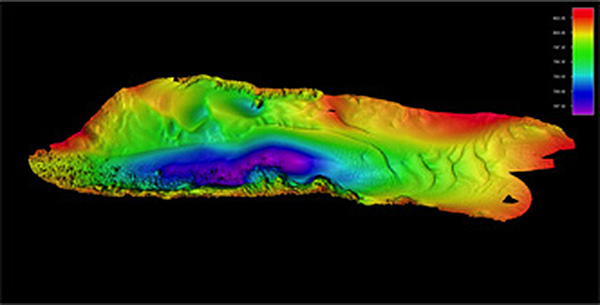
Beneath long-term work to rebuild sandbars in the Grand Canyon lies a legacy of river-running data collection that tells the story of Northern Arizona University researchers, highlighting their persistence and innovations.
A new USGS article in the online journal Eos touts the promising outcomes of controlled floods on the Colorado River, conclusions that rely in part on more than 25 years of measurements collected under difficult conditions and with changing technology.
“It’s a tough place to do research,” said Joe Hazel, research associate at NAU. “You would be hard pressed to find anywhere else in the world where a continuous monitoring record of environmental change was made with direct measurements in a remote river setting.”
At stake is a river ecosystem that has been as challenging to understand as to manage over decades of manipulation since the completion of Glen Canyon Dam. The issue of sandbar deposition and erosion, and the ability to determine just how much sand is in the water and where it comes from, has evolved along with attitudes about how the river should be managed.
“Trying to figure out how much sand is in the system and when to do floods has been the driving force behind our work,” Hazel said. “We tell the managers when the sandbars have eroded to a certain condition or level.”
Hazel and research associate Matt Kaplinski have embarked on nearly 100 river trips since 1989, when they became involved in NAU research that had been ongoing for a decade under pioneering researcher Stan Beus, now NAU regents’ professor emeritus of geology. Beus was instrumental in NAU’s securing of a grant from the Bureau of Reclamation to operate a sandbar monitoring program. Upon Beus’ retirement, Rod Parnell, NAU professor of earth science and environmental sustainability, assumed the title of principal investigator.
“That first year we ran 20 river trips,” Hazel said. The federal government’s continued interest in river monitoring—especially during high-flow experiments in 1996 and 2008—led NAU to produce a trove of information, some of it through methods that have not changed much over the decades, but that has also inspired cutting-edge innovations.
A painstaking process of producing handwritten coordinates from theodolites, measurement devices that have long been the mainstay of surveying, eventually was made easier through digital data collectors. But even then, in what Hazel called “the old days,” river levels would need to be lowered in order to expose sandbars for measurement.
Because 85 percent or more of the sediment is under water, Kaplinski led the development of a multibeam bathymetric system that used sonar to measure submerged sandbars.
“That’s really sophisticated and expensive equipment, and had never before been retrofitted to be used in a canyon setting,” Hazel said, pointing out that the technology is similar to what is being used in the search for missing Malaysian Airlines Flight 370.
Still, collecting the data entails mastering difficult conditions. Using rafts powered by outboard motors, researchers guide equipment worth hundreds of thousands of dollars through rapids, trying not to capsize or slam into a rock.
One payoff of all that work is an approach that appears to endorse continued high-flow experiments as a way to build sandbars over time. Their presence contributes to a downstream ecosystem, which lies within the Glen Canyon Recreation Area and Grand Canyon National Park, considered a World Heritage Site.
“It’s cool that Glen Canyon Dam is now being partially managed to benefit downstream resources instead of just generating hydro power and for water storage,” Hazel said.
And now, after a long and “painful migration process,” the decades of NAU data are available online for anyone to see. What had been relegated to notebooks and outdated floppy disks stored in an old metal cabinet, and generations of incompatible software, is now part of an interactive online database. Researchers around the world can benefit from the findings.
“This is leaving our legacy,” Hazel said. “Now all this data is being served to the public.”
Note : The above story is based on materials provided by Northern Arizona University.










